The company discovered that riders looking to move up from smaller cruisers to a larger model aren’t necessarily interested in or ready for full touring boats, like the Vulcan Voyager, Harley-Davidson’s Electra Glide models or H-D’s Road Glide Ultra.
Of course, the Vaquero is also crafted as a bike with an appeal all its own, drawing in riders that don’t always have a cruiser background – like ZX-14 owners. Long says these riders are part of the
Vaquero’s demographic, as they look either to switch two-wheeled genres or further expand the type of mounts they ride.
And, naturally, with this latest Vulcan, Kawasaki hopes to woo riders from other cruiser brands as well.
During the Vaquero’s recent press launch in Montgomery, Texas, an hour or so north of Houston, Kawasaki staff didn’t specifically say the intent was to get in on the growing bagger sub-segment with the Vaquero, but more often referred to it as the next-step bike mentioned above.
Regardless of how much candor Team Green was willing or able to speak with on this matter of entering the realm of Harley’s Road Glide Custom and Street Glide models, Victory’s Cross Country and Star’s Stratoliner Deluxe, the fact is, with the Vaquero, Kawasaki has beat Honda and Suzuki to the lucrative bagger market.
To give you a sense of how important this part of the cruiser world is, Harley-Davidson says (without revealing any sales figures) the Street Glide is its top-selling model. Perhaps Honda and Suzuki don’t currently have any designs on the bagger game, but it would seem a wise move to join the party.
Another steel horse in the Vulcan stable
At its core the Vaquero is a Vulcan 1700. The latest V bike in Kawi’s big cruiser lineup shares its 1700cc (103.7 c.i.) liquid-cooled, SOHC, four-valve-per-cylinder, 52-degree V-Twin engine carried in a steel-tube cradle-type frame basic platform with its Vulcan Classic, Vulcan Nomad and Vulcan Voyager/ABS stablemates.
Changes to the 1700cc Twin unique to the Vaquero for 2011 include a new second piston ring for “improved durability,” and in the interest of weight reduction the lower primary chain guide was eliminated. Also specific to the Vaquero is a new first-gear ratio said to reduce shifting noise when clicking from neutral to first. Revised cogs for third and fourth gear also work to smooth out shifting action while reducing clatter from the gearbox.
The Vaquero employs the same type of damper-less clutch found in the Vulcan Classic, which Kawasaki says gives the rider an increased feel for the engine, or a “higher torque feel.”
However, a cush drive damper remains in the rear hub. Absence of a clutch damper ostensibly gives the Vaquero “more character.” The Voyager and Nomad retain the clutch damper in order to help reduce some of the sensation of the engine’s power pulses.
According to Long, perceiving the increased engine feel in the Vaquero is likely to depend on the rider and/or the type of riding.
He gave an example of when he and another Kawi employee, both “bigger guys,” immediately noticed the difference between two sample bikes – one with and one without a clutch damper – while riding two-up. Another pair of lighter-weight riders had greater difficulty discerning which bike used the damper-less clutch.
Is removing a degree of smoothness by design a smart marketing move or something more on the gimmicky side?
Hard to say; but then again, if ultimate comfort was a key motivator of V-Twin sales, every V-Twin engine on the market would likely then employ rubber mounting and all manner of engine counter balancing. Yet plenty of cruiser makers do just the opposite, so there seems some merit in Kawi’s effort to give the rider more feel from the Vaquero’s engine.
On the other hand, the aforementioned tranny revisions aimed at reducing noise and increasing smooth shifting seem in contrast to the intent behind taking out the clutch damper. If Kawi presumes a Vaquero rider may want to feel more in touch with the engine, would that same rider then mind a little clank or clunk from the gearbox?
For what it’s worth, I scale in at an out-of-shape 155 lbs and can’t say I really felt the Vaquero engine’s more rugged nature – just as Long indicated some riders might not.
To the contrary, after a150-plus mile loop the Vaquero’s powerplant struck me as considerably smoother than many of its competitors. Maybe only Harley’s rubber-mounted Twin Cam 96 is slightly smoother, but only when under power. At idle the H-D Twin shudders like a paint shaker. The Kawi Twin is smooth at just about every point, including idle, save for some low-resonating vibes around 70 mph when in the rather tall and overdriven 6th gear (5th is also overdriven).
There is, however, enough vibe and rumble from the Vaquero’s dual-counterbalanced engine to satisfy my tastes. One of the aspects I enjoy most about motorcycling is the mechanical-ness of two wheelers and the sounds and feel associated with them – on that level the Vaquero works just fine.
As exhaust works it way out of the Vulcan engine it passes through the Vaquero’s tapered muffler tips said to reduce exhaust decibel levels (Kawi wasn’t willing to state precise decibel figures) at cruising speeds while also mirroring the rest of the bike’s long, flowing look. Last year’s Voyager and Nomad sported slash cut exhaust tips but for 2011 they also get the tapered treatment.
Lastly, the Vaquero’s final drive belt is 2mm narrower, from 28mm to 26mm, for better tracking between the belt’s pulleys and for reduced belt squeal and squeaks.
Ergos on the new Vaquero split the difference between a couple of its Vulcan brothers, for what Kawasaki says is an “expanded rider triangle.” The Vaquero’s floorboards are set in the same position as the Nomad’s, that is, more forward than the other Vulcans, and its all-new, tapered one-piece seat has a lumbar shape – or hump – similar to the Classic’s saddle.
The Vaquero seat is also ready to accept an accessory rider backrest and quick-release passenger backrest, while a separate accessory seat accommodates passengers better than the standard saddle.
The Vulcan Classic still offers the lowest seat height of all 1700 Vulcans at 28.3 inches, while the Vaquero, Nomad and Voyager all have 28.7-inch seat heights. Victory’s Cross Country and Cross Roads boast an even lower 26.25-inch seat height. The Harley Road Glide Custom, a direct competitor to the Vaquero, has a seat height 1.6 inches lower than the touring Vulcans, but it and the Street Glide also have pitifully less rear suspension travel.
Accessing the Vaquero’s dual air valves for the shocks is as simple as removing the seat; total pressure range for rear suspension is 0-40 psi. Recommend setting for a 150-lbs rider with empty luggage is 0.0 psi.
For the moto media’s test ride, Kawi techs set the shocks to 15 psi; the setting proved ideal for my 150-ish lbs frame. A Kawi staffer who weighs considerably more (I’ll spare him a guess at his “healthy” weight) said he often rides the Vaquero with the preload set only 5-psi higher.
Victory’s bar-mounted fairing bagger, the Cross Country, has even more rear suspension travel with 4.7 inches, as does the Star Stratoliner Deluxe with 4.3 inches. Reflecting on our recent Bagger Shootout that included the Vic and Star, I can say that despite more rear suspension travel than what the Vaquero has, neither of those bikes provides a significantly more forgiving ride than the Vaquero
The Voyager’s 45mm fork is given to the new Vaquero, while the Vulcan Nomad and Classic have a 43mm unit. Front suspension travel for the Voyager and Vaquero is 5.5 inches – 0.4 inches more than in the 43mm inverted fork on both the Cross Country and Cross Roads.
The Vaquero’s rather plump-looking 130/90 x 16 Bridgestone Exedra radial front tire appears like it might make for slow steering response; however, the front bun is a good pairing to the 170/70 x 16 rear tire. Neutral handling is a key characteristic of the Vaquero; steering effort is light, with a fluid, linear movement from upright to full lean.
This Vulcan’s claimed curb weight is 836-lbs. That’s 25 lbs more than the Road Glide Custom’s running order weight, and a whopping 41 lbs more than what Star says Strato Deluxe weighs fueled and ready to ride.
The Vaquero’s lean angle clearance isn’t as generous as that of the Victory Cross bikes – few cruisers in this class offer as much as the Vics – but is at worst, average. Standard calipers gripping 300mm discs handle braking, and at this time ABS is only available on the Euro version of the Vaquero. Only the heavier Vulcan Voyager offers optional ABS. Excluding ABS from the Vaquero seems inline with what the rest of the market is doing with baggers that aren’t intended as long-haul tourers.
Styling is elemental to cruiser/bagger design, and the Vaquero’s smooth, flowing lines, from the frame-mounted fairing with color matched inner fairing to the sculpted hardbags weaved into the shape of the tail section, the Vaquero’s look says that form is just as important as function for this Kawasaki.
It’s prudent that the Vaquero’s bags require a key (same as ignition) to open and close so as to prevent your stuff readily dumping out. But the bags’ fixed mounting method, rather than a tool-less and easily removed Dzus fitting like the Harley and Victory use, makes accessing each of the Vulcan shock’s rebound damping adjuster atop the shock body unnecessarily frustrating. You’ll need patience or smallish hands, or both, to reach behind the saddlebags in order tweak the shocks.
Contrary to this lil’ shock access peccadillo is Kawasaki’s thoughtfulness in placing two helmet hooks under the saddle.
The large fairing and almost-not-there, style-conscious 6.0-inch windscreen sufficiently protected my 5-foot 8-inch frame from the wind without excessive buffeting, but taller riders may have a different, less favorable experience. A simple remedy for unwanted windblast is to choose from one of five optional screens ranging from 6.5 inches to 18.0 inches in height.
Speaking of options for the Vaquero, about the only one not on offer is ABS. The Vaquero is otherwise just about as loaded as any bagger comes, with a robust sound system providing AM/FM/WX, and is XM ready – all that’s necessary is the accessory XM module – while the AUX mode on the sound system allows use of an MP3 player via an accessory adapter.
The sound system’s volume/mode and track/station selector switches on the left-side switch gear are joined by a built-in CB function switch that waits patiently for the addition of an optional CB system. Switches for the standard cruise control (also on Voyager and Nomad) are located on the right-hand switch housing. Cruise activates when in 3rd gear or any speeds between 30 and 85 mph.
A rider can increase or decrease cruise speed by as little as 1 mph at a time thanks to the EVT (Electronic Throttle Valve – type of throttle-by-wire) used on the Vaquero as well as on the Nomad and Voyager.
On the subject of adapters and music, the Vaquero’s left-side locking glove compartment is prewired to plug into Kawasaki’s accessory iPod adapter kit that comes with a foam-rubber holder for your iPod. The adapter is pre-molded in the shape of the compartment for a secure fit.
Thirty-five accessories are available now with many more in the chute; and when it came time to plan for Vaquero accessories, Kawasaki took a calculated approach to making the bike as plug-n-play as possible.
The bike’s wiring harness has many accessory plugs prewired (like the aforementioned iPod connector plug), and the ability to purchase accessories a la carte allows a consumer a modular path to building exactly the Vaquero they want without committing to extras they aren’t necessarily interested in.
Ride ‘im, cowboy!
Prior to the Vaquero’s launch, the Victory Cross Country arguably provided a whole lot of bang for the buck.
The Vic offers the roomiest saddlebags in the class, a comprehensive sound system, second-largest V-Twin in the class, a stout aluminum frame joined by excellent overall ride quality and comfort, all for $17,999.
Although the 2011 Kawasaki Vulcan 1700 Vaquero’s 1700cc engine isn’t quite as big as the Victory’s 1731cc lump, when we lasted dyno tested a Vulcan 1700cc in the Vulcan Classic vs. Triumph Thunderbird comparo, the Vulcan managed 86.3 peak ft-lbs. In our 2011 Bagger Shootout the Victory Cross Country churned out just less than 89 ft-lbs.
We’d expect a little better performance from the Vulcan’s liquid-cooled engine, but then again we’re only talking a deficit of a couple ft-lbs.
Furthermore, the Vulcan’s chassis performance and ride comfort are right there with the Victory. And the Vaquero provides a level of rider entertainment comparable to the Cross Country, including multi-menu access for MP3 players. Standard cruise also matches the Victory.
One of the few areas the Kawasaki comes up short to the Cross Country is hardbag volume. But the Vaquero’s impressive standard three-year warranty with optional warranty add-ons extending base coverage an additional one to three years is a rare offering in the moto world. And the warranty remains in tact if you use Kawasaki accessories.
Star’s Stratoliner Deluxe has the most powerful V-Twin in the segment, but beyond the extra power, and an iPod connector in its batwing fairing, it’s hard to justify the Star’s $17,499 price in the face of the competition.
No question the Vaquero is influenced by the venerable Road Glide Custom from Harley. The bike from Milwaukee is a quality machine and it has an excellent dash, but for now H-D doesn’t offer a plug and play setup for the iPod – something I see as a new standard.
Then of course there’s the issue of the Harley RG Custom’s smaller 96 c.i. Twin (good for 80.4 ft-lbs the last time we dyno’d), not-so-great rear suspension, the extra $295 required for cruise control and a class-topping base MSRP of $18,999. In fairness, what Harley does boast over most other brands is typically good resale value.
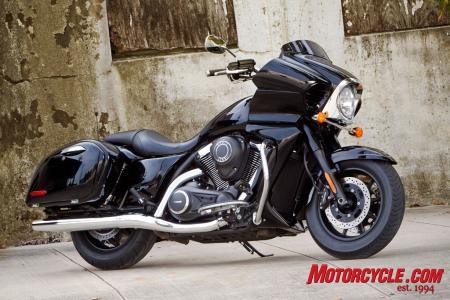 |
| Top 2013 Kawasaki Vulcan 1700 Vaquero Review |
Vaquero’s demographic, as they look either to switch two-wheeled genres or further expand the type of mounts they ride.
2011 Kawasaki Vulcan 1700 Vaquero. This latest bike to join the big-bore Vulcan lineup is Kawasaki’s step into what is known as the bagger cruiser segment. Other bikes in this category include Harley-Davidson’s Street Glide, Road Glide Custom and Victory’s Cross Country, to name just a couple. |
And, naturally, with this latest Vulcan, Kawasaki hopes to woo riders from other cruiser brands as well.
During the Vaquero’s recent press launch in Montgomery, Texas, an hour or so north of Houston, Kawasaki staff didn’t specifically say the intent was to get in on the growing bagger sub-segment with the Vaquero, but more often referred to it as the next-step bike mentioned above.
Regardless of how much candor Team Green was willing or able to speak with on this matter of entering the realm of Harley’s Road Glide Custom and Street Glide models, Victory’s Cross Country and Star’s Stratoliner Deluxe, the fact is, with the Vaquero, Kawasaki has beat Honda and Suzuki to the lucrative bagger market.
The Vaquero’s styling is undeniably influenced by Harley’s Road Glide Custom. However, Kawi adds various touches to the Vaquero’s looks, like the Candy Fire Red bike’s color-matched headlight trim and color-matched inner fairing, in an effort to set the Vaquero apart from its competition. |
To give you a sense of how important this part of the cruiser world is, Harley-Davidson says (without revealing any sales figures) the Street Glide is its top-selling model. Perhaps Honda and Suzuki don’t currently have any designs on the bagger game, but it would seem a wise move to join the party.
Another steel horse in the Vulcan stable
At its core the Vaquero is a Vulcan 1700. The latest V bike in Kawi’s big cruiser lineup shares its 1700cc (103.7 c.i.) liquid-cooled, SOHC, four-valve-per-cylinder, 52-degree V-Twin engine carried in a steel-tube cradle-type frame basic platform with its Vulcan Classic, Vulcan Nomad and Vulcan Voyager/ABS stablemates.
Changes to the 1700cc Twin unique to the Vaquero for 2011 include a new second piston ring for “improved durability,” and in the interest of weight reduction the lower primary chain guide was eliminated. Also specific to the Vaquero is a new first-gear ratio said to reduce shifting noise when clicking from neutral to first. Revised cogs for third and fourth gear also work to smooth out shifting action while reducing clatter from the gearbox.
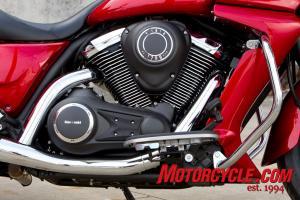 |
| Top 2013 Kawasaki Vulcan 1700 Vaquero Review |
A lot of external components that would usually have chrome surfaces get the black-out treatment on the Vaquero. Although the Vaquero’s 1700cc V-Twin is largely the same engine as its Vulcan 1700 mates use, a few tweaks were given to the Vaquero’s powerplant.
Kawasaki noted that most Vulcan fans are satisfied with how the engine sounds and performs, but some riders with a touring bent requested a reduction of the noises generated when shifting gears. Finicky lot.The Vaquero employs the same type of damper-less clutch found in the Vulcan Classic, which Kawasaki says gives the rider an increased feel for the engine, or a “higher torque feel.”
However, a cush drive damper remains in the rear hub. Absence of a clutch damper ostensibly gives the Vaquero “more character.” The Voyager and Nomad retain the clutch damper in order to help reduce some of the sensation of the engine’s power pulses.
According to Long, perceiving the increased engine feel in the Vaquero is likely to depend on the rider and/or the type of riding.
He gave an example of when he and another Kawi employee, both “bigger guys,” immediately noticed the difference between two sample bikes – one with and one without a clutch damper – while riding two-up. Another pair of lighter-weight riders had greater difficulty discerning which bike used the damper-less clutch.
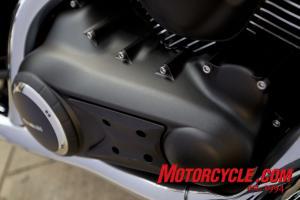 |
| Top 2013 Kawasaki Vulcan 1700 Vaquero Review |
A damper was eliminated from the Vaquero’s clutch in order to allow the rider a greater sense of engine feel. Minor changes to the transmission were put in place to reduce noises from the gearbox.
The unstated premise here is that a touring rig, one carrying a passenger and full up with gear, should better nullify engine shakes, rattles and rolls so as to allow the touring rider a more enjoyable tour, if you will. Kawasaki dubs the Vaquero as the “ultimate solo cruiser with unmatched style, power and comfort.” We might infer from this that a Vaquero customer is perhaps more interested in the bike’s performance quotient and might value the engine’s visceral appeal more than he or she would the highest level possible for comfort.Is removing a degree of smoothness by design a smart marketing move or something more on the gimmicky side?
Hard to say; but then again, if ultimate comfort was a key motivator of V-Twin sales, every V-Twin engine on the market would likely then employ rubber mounting and all manner of engine counter balancing. Yet plenty of cruiser makers do just the opposite, so there seems some merit in Kawi’s effort to give the rider more feel from the Vaquero’s engine.
On the other hand, the aforementioned tranny revisions aimed at reducing noise and increasing smooth shifting seem in contrast to the intent behind taking out the clutch damper. If Kawi presumes a Vaquero rider may want to feel more in touch with the engine, would that same rider then mind a little clank or clunk from the gearbox?
The few updates to the Vaquero’s engine might help some riders feel more connected to the big Twin. However, Pete found the Vaquero’s overall ride about as smooth as possible, and for that he was grateful. |
For what it’s worth, I scale in at an out-of-shape 155 lbs and can’t say I really felt the Vaquero engine’s more rugged nature – just as Long indicated some riders might not.
To the contrary, after a150-plus mile loop the Vaquero’s powerplant struck me as considerably smoother than many of its competitors. Maybe only Harley’s rubber-mounted Twin Cam 96 is slightly smoother, but only when under power. At idle the H-D Twin shudders like a paint shaker. The Kawi Twin is smooth at just about every point, including idle, save for some low-resonating vibes around 70 mph when in the rather tall and overdriven 6th gear (5th is also overdriven).
There is, however, enough vibe and rumble from the Vaquero’s dual-counterbalanced engine to satisfy my tastes. One of the aspects I enjoy most about motorcycling is the mechanical-ness of two wheelers and the sounds and feel associated with them – on that level the Vaquero works just fine.
As exhaust works it way out of the Vulcan engine it passes through the Vaquero’s tapered muffler tips said to reduce exhaust decibel levels (Kawi wasn’t willing to state precise decibel figures) at cruising speeds while also mirroring the rest of the bike’s long, flowing look. Last year’s Voyager and Nomad sported slash cut exhaust tips but for 2011 they also get the tapered treatment.
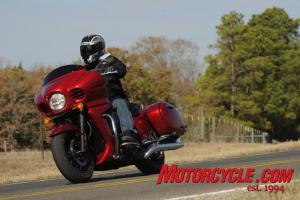 |
| Top 2013 Kawasaki Vulcan 1700 Vaquero Review |
A new casting mold for the intake manifold is said to increase flow volume for more linear throttle response and improved idle; this update is given to all 1700cc Vulcans. The combination of changes to the intake manifold and exhaust necessitated changes to the ECU, and so all Vulcan 1700s have an updated brain for 2011.
Lastly, the Vaquero’s final drive belt is 2mm narrower, from 28mm to 26mm, for better tracking between the belt’s pulleys and for reduced belt squeal and squeaks.
Ergos on the new Vaquero split the difference between a couple of its Vulcan brothers, for what Kawasaki says is an “expanded rider triangle.” The Vaquero’s floorboards are set in the same position as the Nomad’s, that is, more forward than the other Vulcans, and its all-new, tapered one-piece seat has a lumbar shape – or hump – similar to the Classic’s saddle.
The Vaquero seat is also ready to accept an accessory rider backrest and quick-release passenger backrest, while a separate accessory seat accommodates passengers better than the standard saddle.
The Vulcan Classic still offers the lowest seat height of all 1700 Vulcans at 28.3 inches, while the Vaquero, Nomad and Voyager all have 28.7-inch seat heights. Victory’s Cross Country and Cross Roads boast an even lower 26.25-inch seat height. The Harley Road Glide Custom, a direct competitor to the Vaquero, has a seat height 1.6 inches lower than the touring Vulcans, but it and the Street Glide also have pitifully less rear suspension travel.
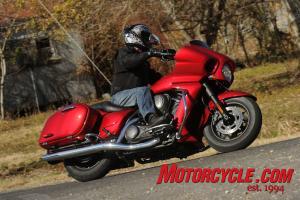 |
| Top 2013 Kawasaki Vulcan 1700 Vaquero Review |
The Vaquero’s ride comfort, agility and ease-of-use are on par with the Cross Country from Victory.
Where the Vaquero offers 3.1 inches of rear travel from its dual shocks with air-adjustable preload and four-way rebound damping (same for all Vulcan 1700s), the Harley’s air-adjustable shocks move a mere 2.0 inches. The Vaquero’s combo of thick seat foam and ample rear suspension travel make for a downright plush ride compared to the often-jolting experience a rider gets from the back half of either Harley ‘Glides.Accessing the Vaquero’s dual air valves for the shocks is as simple as removing the seat; total pressure range for rear suspension is 0-40 psi. Recommend setting for a 150-lbs rider with empty luggage is 0.0 psi.
For the moto media’s test ride, Kawi techs set the shocks to 15 psi; the setting proved ideal for my 150-ish lbs frame. A Kawi staffer who weighs considerably more (I’ll spare him a guess at his “healthy” weight) said he often rides the Vaquero with the preload set only 5-psi higher.
Victory’s bar-mounted fairing bagger, the Cross Country, has even more rear suspension travel with 4.7 inches, as does the Star Stratoliner Deluxe with 4.3 inches. Reflecting on our recent Bagger Shootout that included the Vic and Star, I can say that despite more rear suspension travel than what the Vaquero has, neither of those bikes provides a significantly more forgiving ride than the Vaquero
The Voyager’s 45mm fork is given to the new Vaquero, while the Vulcan Nomad and Classic have a 43mm unit. Front suspension travel for the Voyager and Vaquero is 5.5 inches – 0.4 inches more than in the 43mm inverted fork on both the Cross Country and Cross Roads.
Some folks might find the louvers flanking the headlight ostentatious, but they’re replaceable with auxiliary lights (same as those on the Vulcan Voyager) as part of the Vaquero’s robust collection of accessories. The Vaquero is prewired and ready to accept the lights as well as many other extras, like rider-to-rider comm., 12-volt power port, CB, etc. |
The Vaquero’s rather plump-looking 130/90 x 16 Bridgestone Exedra radial front tire appears like it might make for slow steering response; however, the front bun is a good pairing to the 170/70 x 16 rear tire. Neutral handling is a key characteristic of the Vaquero; steering effort is light, with a fluid, linear movement from upright to full lean.
This Vulcan’s claimed curb weight is 836-lbs. That’s 25 lbs more than the Road Glide Custom’s running order weight, and a whopping 41 lbs more than what Star says Strato Deluxe weighs fueled and ready to ride.
The Vaquero’s lean angle clearance isn’t as generous as that of the Victory Cross bikes – few cruisers in this class offer as much as the Vics – but is at worst, average. Standard calipers gripping 300mm discs handle braking, and at this time ABS is only available on the Euro version of the Vaquero. Only the heavier Vulcan Voyager offers optional ABS. Excluding ABS from the Vaquero seems inline with what the rest of the market is doing with baggers that aren’t intended as long-haul tourers.
Styling is elemental to cruiser/bagger design, and the Vaquero’s smooth, flowing lines, from the frame-mounted fairing with color matched inner fairing to the sculpted hardbags weaved into the shape of the tail section, the Vaquero’s look says that form is just as important as function for this Kawasaki.
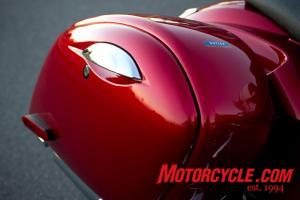 |
| Top 2013 Kawasaki Vulcan 1700 Vaquero Review |
Locking hardbags are a key element of the Vaquero’s style, and they work well. However, styling dictated approximately a 0.5-gallon reduction in storage capacity when compared to bags on the Nomad and Voyager.
All is not perfect, unfortunately, as the faux tank strap doesn’t fully disguise its plastic reality; and in a sacrifice to style the Vaquero’s 9.6-gallons-each side loading saddlebags lost about half a gallon of space compared to the Voyager and Nomad’s top-loading bags. The Vaquero’s bags operate with a reassuringly solid-functioning chrome handle/latch.It’s prudent that the Vaquero’s bags require a key (same as ignition) to open and close so as to prevent your stuff readily dumping out. But the bags’ fixed mounting method, rather than a tool-less and easily removed Dzus fitting like the Harley and Victory use, makes accessing each of the Vulcan shock’s rebound damping adjuster atop the shock body unnecessarily frustrating. You’ll need patience or smallish hands, or both, to reach behind the saddlebags in order tweak the shocks.
Contrary to this lil’ shock access peccadillo is Kawasaki’s thoughtfulness in placing two helmet hooks under the saddle.
The large fairing and almost-not-there, style-conscious 6.0-inch windscreen sufficiently protected my 5-foot 8-inch frame from the wind without excessive buffeting, but taller riders may have a different, less favorable experience. A simple remedy for unwanted windblast is to choose from one of five optional screens ranging from 6.5 inches to 18.0 inches in height.
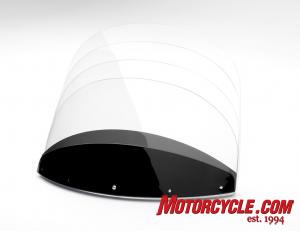 |
| Top 2013 Kawasaki Vulcan 1700 Vaquero Review |
No, this isn’t some wacky new ratcheting windscreen for the Vaquero, but is a graphic display of the six different available shield heights, including the standard short screen.
The standard screen and optional 6.5-inch unit are both dark tint; the remaining taller accessory screens are only available in clear.Speaking of options for the Vaquero, about the only one not on offer is ABS. The Vaquero is otherwise just about as loaded as any bagger comes, with a robust sound system providing AM/FM/WX, and is XM ready – all that’s necessary is the accessory XM module – while the AUX mode on the sound system allows use of an MP3 player via an accessory adapter.
The sound system’s volume/mode and track/station selector switches on the left-side switch gear are joined by a built-in CB function switch that waits patiently for the addition of an optional CB system. Switches for the standard cruise control (also on Voyager and Nomad) are located on the right-hand switch housing. Cruise activates when in 3rd gear or any speeds between 30 and 85 mph.
A rider can increase or decrease cruise speed by as little as 1 mph at a time thanks to the EVT (Electronic Throttle Valve – type of throttle-by-wire) used on the Vaquero as well as on the Nomad and Voyager.
On the subject of adapters and music, the Vaquero’s left-side locking glove compartment is prewired to plug into Kawasaki’s accessory iPod adapter kit that comes with a foam-rubber holder for your iPod. The adapter is pre-molded in the shape of the compartment for a secure fit.
The Vaquero’s comprehensive sound system is ready to accept XM radio and music from your iPod after adding necessary accessory adapters. The red bike’s inner fairing receives a second paint treatment to ensure a smooth, glossy finish. |
Thirty-five accessories are available now with many more in the chute; and when it came time to plan for Vaquero accessories, Kawasaki took a calculated approach to making the bike as plug-n-play as possible.
The bike’s wiring harness has many accessory plugs prewired (like the aforementioned iPod connector plug), and the ability to purchase accessories a la carte allows a consumer a modular path to building exactly the Vaquero they want without committing to extras they aren’t necessarily interested in.
Ride ‘im, cowboy!
Prior to the Vaquero’s launch, the Victory Cross Country arguably provided a whole lot of bang for the buck.
The Vic offers the roomiest saddlebags in the class, a comprehensive sound system, second-largest V-Twin in the class, a stout aluminum frame joined by excellent overall ride quality and comfort, all for $17,999.
“On a steel horse I ride…” The name Vaquero is Spanish for cowboy. The Vulcan Vaquero’s ergos suited Pete’s 5-foot 8-inch frame and 30-inch inseam perfectly. |
Although the 2011 Kawasaki Vulcan 1700 Vaquero’s 1700cc engine isn’t quite as big as the Victory’s 1731cc lump, when we lasted dyno tested a Vulcan 1700cc in the Vulcan Classic vs. Triumph Thunderbird comparo, the Vulcan managed 86.3 peak ft-lbs. In our 2011 Bagger Shootout the Victory Cross Country churned out just less than 89 ft-lbs.
We’d expect a little better performance from the Vulcan’s liquid-cooled engine, but then again we’re only talking a deficit of a couple ft-lbs.
Furthermore, the Vulcan’s chassis performance and ride comfort are right there with the Victory. And the Vaquero provides a level of rider entertainment comparable to the Cross Country, including multi-menu access for MP3 players. Standard cruise also matches the Victory.
One of the few areas the Kawasaki comes up short to the Cross Country is hardbag volume. But the Vaquero’s impressive standard three-year warranty with optional warranty add-ons extending base coverage an additional one to three years is a rare offering in the moto world. And the warranty remains in tact if you use Kawasaki accessories.
Star’s Stratoliner Deluxe has the most powerful V-Twin in the segment, but beyond the extra power, and an iPod connector in its batwing fairing, it’s hard to justify the Star’s $17,499 price in the face of the competition.
No question the Vaquero is influenced by the venerable Road Glide Custom from Harley. The bike from Milwaukee is a quality machine and it has an excellent dash, but for now H-D doesn’t offer a plug and play setup for the iPod – something I see as a new standard.
This Kawasaki cowboy is looking to stir up trouble with all the other baggers in town. |
Then of course there’s the issue of the Harley RG Custom’s smaller 96 c.i. Twin (good for 80.4 ft-lbs the last time we dyno’d), not-so-great rear suspension, the extra $295 required for cruise control and a class-topping base MSRP of $18,999. In fairness, what Harley does boast over most other brands is typically good resale value.

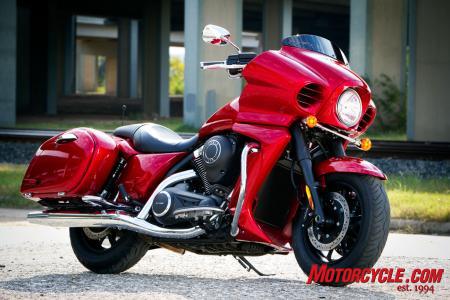
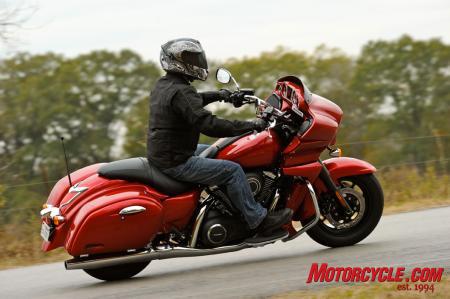
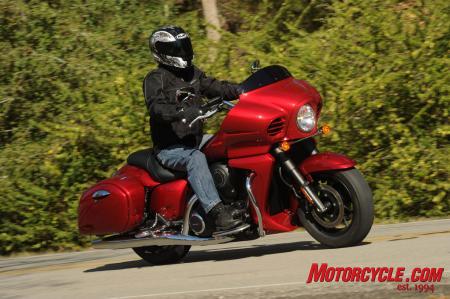
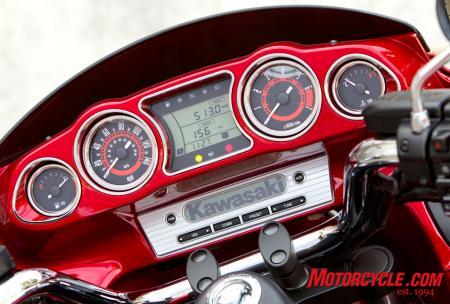
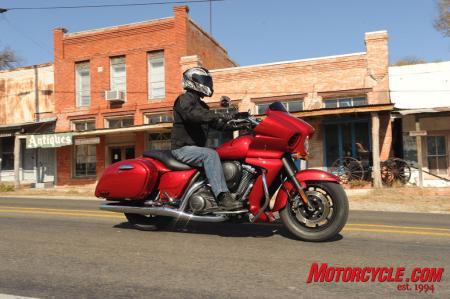
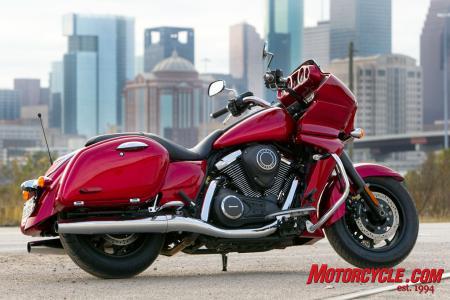
No comments:
Post a Comment